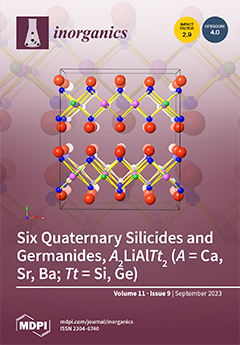The unexpected tetranuclear [Cu
4(DPPT)
2Cl
6] complex was obtained by self-assembly of CuCl
2.2H
2O and (
E)-2,4-di(piperidin-1-yl)-6-(2-(1-(pyridin-2-yl)ethylidene)hydrazinyl)-1,3,5-triazine, (
HDPPT) in ethanol. In this tetranuclear [Cu
4(DPPT)
2Cl
6] complex, the organic
[...] Read more.
The unexpected tetranuclear [Cu
4(DPPT)
2Cl
6] complex was obtained by self-assembly of CuCl
2.2H
2O and (
E)-2,4-di(piperidin-1-yl)-6-(2-(1-(pyridin-2-yl)ethylidene)hydrazinyl)-1,3,5-triazine, (
HDPPT) in ethanol. In this tetranuclear [Cu
4(DPPT)
2Cl
6] complex, the organic ligand acts as mononegative chelate bridging two crystallographically independent Cu(II) sites. The
DPPT− anion acts as a bidentate ligand with respect to Cu(1), while it is a tridentate for Cu(2). The Cu(1)N
2Cl
3 and Cu(2)N
3Cl spheres have square pyramidal and square planar coordination geometries with some distortion, respectively. Two of the chloride ions coordinating the Cu(1) are bridging between two crystallographically related Cu(1) sites connecting two [Cu
2(DPPT)Cl
3] units together, leading to the tetranuclear formula [Cu
4(DPPT)
2Cl
6]. The packing of the [Cu
4(DPPT)
2Cl
6] complex is dominated by C-H…Cl contacts, leading to one-dimensional hydrogen-bond polymeric structure. According to Hirshfeld surface analysis of molecular packing, the non-covalent interactions H…H, Cl…H, Cl…C, C…H, and N…H are the most significant. Their percentages are 52.8, 19.0, 3.2, 7.7, and 9.7%, respectively. Antimicrobial assessment showed good antifungal activity of the Cu(II) complex against
A. fumigatus and
C. albicans compared to Ketoconazole as positive control. Moreover, the [Cu
4(DPPT)
2Cl
6] complex has higher activity against Gram-positive bacteria than
Gentamycin as positive control. The opposite was observed when testing the tetranuclear [Cu
4(DPPT)
2Cl
6] complex against the Gram-negative bacteria.
Full article





